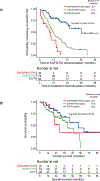Concurrent RB1 and TP53 Alterations Define a Subset of EGFR-Mutant Lung Cancers at risk for Histologic Transformation and Inferior Clinical Outcomes
- PMID: 31228622
- PMCID: PMC6764905
- DOI: 10.1016/j.jtho.2019.06.002
Concurrent RB1 and TP53 Alterations Define a Subset of EGFR-Mutant Lung Cancers at risk for Histologic Transformation and Inferior Clinical Outcomes
Abstract
Introduction: EGFR-mutant lung cancers are clinically and genomically heterogeneous with concurrent RB transcriptional corepressor 1 (RB1)/tumor protein p53 (TP53) alterations identifying a subset at increased risk for small cell transformation. The genomic alterations that induce lineage plasticity are unknown.
Methods: Patients with EGFR/RB1/TP53-mutant lung cancers, identified by next-generation sequencing from 2014 to 2018, were compared to patients with untreated, metastatic EGFR-mutant lung cancers without both RB1 and TP53 alterations. Time to EGFR-tyrosine kinase inhibitor discontinuation, overall survival, SCLC transformation rate, and genomic alterations were evaluated.
Results: Patients with EGFR/RB1/TP53-mutant lung cancers represented 5% (43 of 863) of EGFR-mutant lung cancers but were uniquely at risk for transformation (7 of 39, 18%), with no transformations in EGFR-mutant lung cancers without baseline TP53 and RB1 alterations. Irrespective of transformation, patients with EGFR/TP53/RB1-mutant lung cancers had a shorter time to discontinuation than EGFR/TP53- and EGFR-mutant -only cancers (9.5 versus 12.3 versus 36.6 months, respectively, p = 2 × 10-9). The triple-mutant population had a higher incidence of whole-genome doubling compared to NSCLC and SCLC at large (80% versus 34%, p < 5 × 10-9 versus 51%, p < 0.002, respectively) and further enrichment in triple-mutant cancers with eventual small cell histology (seven of seven pre-transformed plus four of four baseline SCLC versus 23 of 32 never transformed, respectively, p = 0.05). Activation-induced cytidine deaminase/apolipoprotein B mRNA editing enzyme, catalytic polypeptide-like mutation signature was also enriched in triple-mutant lung cancers that transformed (false discovery rate = 0.03).
Conclusions: EGFR/TP53/RB1-mutant lung cancers are at unique risk of histologic transformation, with 25% presenting with de novo SCLC or eventual small cell transformation. Triple-mutant lung cancers are enriched in whole-genome doubling and Activation-induced cytidine deaminase/apolipoprotein B mRNA editing enzyme, catalytic polypeptide-like hypermutation which may represent early genomic determinants of lineage plasticity.
Keywords: EGFR-mutation; RB1; Small cell histologic transformation; TP53; Whole genome doubling.
Copyright © 2019. Published by Elsevier Inc.
Conflict of interest statement
Conflict of Interest Statement:
All other authors have declared no relevant conflicts of interest.
Figures




Comment in
-
Histologically Transformed SCLC From EGFR-Mutant NSCLC: Understanding the Wolf in Sheep's Clothing.J Thorac Oncol. 2019 Oct;14(10):1689-1691. doi: 10.1016/j.jtho.2019.07.010. J Thorac Oncol. 2019. PMID: 31558227 No abstract available.
Similar articles
-
EGFR-Mutant Adenocarcinomas That Transform to Small-Cell Lung Cancer and Other Neuroendocrine Carcinomas: Clinical Outcomes.J Clin Oncol. 2019 Feb 1;37(4):278-285. doi: 10.1200/JCO.18.01585. Epub 2018 Dec 14. J Clin Oncol. 2019. PMID: 30550363 Free PMC article.
-
Transformation or tumor heterogeneity: Mutations in EGFR, SOX2, TP53, and RB1 persist in the histological rapid conversion from lung adenocarcinoma to small-cell lung cancer.Thorac Cancer. 2023 Apr;14(11):1036-1041. doi: 10.1111/1759-7714.14832. Epub 2023 Feb 21. Thorac Cancer. 2023. PMID: 36810856 Free PMC article.
-
Clinicopathological and genomic comparisons between different histologic components in combined small cell lung cancer and non-small cell lung cancer.Lung Cancer. 2018 Nov;125:282-290. doi: 10.1016/j.lungcan.2018.10.006. Epub 2018 Oct 9. Lung Cancer. 2018. PMID: 30429033
-
Patients outcomes in lung adenocarcinoma transforming to small-cell lung cancer after tyrosine kinase inhibitor therapy.World J Surg Oncol. 2025 Feb 1;23(1):34. doi: 10.1186/s12957-025-03687-4. World J Surg Oncol. 2025. PMID: 39893475 Free PMC article.
-
Current knowledge of small cell lung cancer transformation from non-small cell lung cancer.Semin Cancer Biol. 2023 Sep;94:1-10. doi: 10.1016/j.semcancer.2023.05.006. Epub 2023 May 26. Semin Cancer Biol. 2023. PMID: 37244438 Review.
Cited by
-
Rapid Disease Progression in a Patient with Advanced NSCLC Harboring a Germline MET Exon 14 Skipping Mutation: A Case Report.Onco Targets Ther. 2021 Apr 7;14:2417-2421. doi: 10.2147/OTT.S295542. eCollection 2021. Onco Targets Ther. 2021. PMID: 33854337 Free PMC article.
-
The great need to overcome osimertinib resistance in advanced non-small cell lung cancer: from combination strategies to fourth-generation tyrosine kinase inhibitors.Front Oncol. 2024 Jan 9;13:1308460. doi: 10.3389/fonc.2023.1308460. eCollection 2023. Front Oncol. 2024. PMID: 38264760 Free PMC article. No abstract available.
-
Anoikis-related gene signature is associated with immune infiltration and predicts the prognosis of non-small cell lung cancer.Aging (Albany NY). 2024 Feb 7;16(3):2908-2933. doi: 10.18632/aging.205522. Epub 2024 Feb 7. Aging (Albany NY). 2024. PMID: 38329444 Free PMC article.
-
Transformation to small cell lung cancer is irrespective of EGFR and accelerated by SMAD4-mediated ASCL1 transcription independently of RB1 in non-small cell lung cancer.Cell Commun Signal. 2024 Jan 17;22(1):45. doi: 10.1186/s12964-023-01260-8. Cell Commun Signal. 2024. PMID: 38233864 Free PMC article.
-
Overcoming therapy resistance in EGFR-mutant lung cancer.Nat Cancer. 2021 Apr;2(4):377-391. doi: 10.1038/s43018-021-00195-8. Epub 2021 Apr 15. Nat Cancer. 2021. PMID: 35122001 Review.
References
-
- Jordan EJ, Kim HR, Arcila ME, et al. Prospective Comprehensive Molecular Characterization of Lung Adenocarcinomas for Efficient Patient Matching to Approved and Emerging Therapies. Cancer Discov 2017;7:596–609. 10.1158/2159-8290.cd-16-1337. - DOI - PMC - PubMed
-
- Piotrowska Z, Isozaki H, Lennerz JK, et al. Landscape of Acquired Resistance to Osimertinib in EGFR-Mutant NSCLC and Clinical Validation of Combined EGFR and RET Inhibition with Osimertinib and BLU-667 for Acquired RET Fusion. Cancer Discov 2018;8:1529–1539. 10.1158/2159-8290.CD-18-1022. - DOI - PMC - PubMed
Publication types
MeSH terms
Substances
Grants and funding
LinkOut - more resources
Full Text Sources
Other Literature Sources
Research Materials
Miscellaneous

